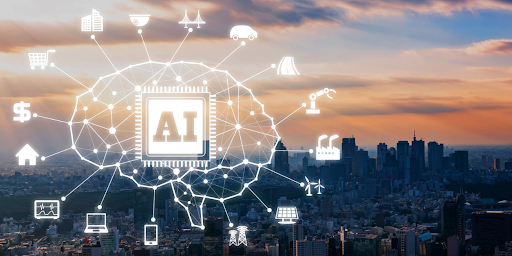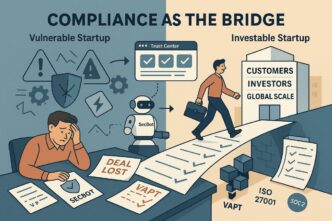How did AI reshape various sectors in the pivotal year of 2023, from healthcare to finance and education? With its profound impact on streamlining processes, improving decision-making, and predicting outcomes, can we anticipate an even more integrated role for AI in our day-to-day activities as we step into 2024?
Now, as we transition into 2024, the future of AI is a topic of intense anticipation. We can expect the upcoming year to be another transformative period, with AI becoming even more integrated into our day-to-day activities.
Let’s explore these top five predictions for AI in 2024, offering insights into a future where the influence of AI is even more profound and far-reaching.
How AI Will Become More Integrated in Our Daily Lives
AI is no longer a mere concept of the future; it has become an integral part of our present reality. Businesses across the globe are set to accelerate their integration of AI into various operations, paving the way for a new era of efficiency and innovation.
AI’s potential for automation is expected to be harnessed even more extensively. From customer service chatbots to intelligent process automation, businesses are likely to leverage AI to streamline their operations, reduce costs, and enhance customer experience.
One of the most prominent examples is Microsoft, renowned for its comprehensive integration strategy. With AI, Microsoft can further streamline its operations from production to distribution, enhancing efficiency and reducing costs.
Amazon is another testament to the power of AI integration. The e-commerce giant leverages AI for personalized recommendations, intelligent search, and automated warehousing, significantly improving customer experience and operational efficiency.
The Rise of ‘Centaur Teams’
A new model of collaboration is taking center stage – the concept of ‘Centaur Teams’. This term, borrowed from the game of chess, refers to the powerful combination of human intuition and artificial intelligence.
Contrary to popular belief, AI is not here to replace humans but to augment their capabilities. As the tech experts at InclusionCloud have stated,, “Generative AI doesn’t aim to replace human tasks; its true potential lies in augmenting and amplifying human capabilities”. By doing so, it not only boosts productivity but also enhances job satisfaction, thereby reducing employee turnover.
AI additionally can provide useful insights into employee behavior, assisting managers in identifying early signs of disengagement or burnout. This enables quick intervention, which contributes to the retention of talent inside enterprises. The rise of ‘Centaur Teams’ signifies a shift in our understanding of AI. Rather than viewing it as a threat, businesses are beginning to appreciate the immense potential of AI-human collaboration. As we move forward, this synergy will only deepen, making our workplaces more efficient, innovative, and human-centric.
Anticipating AI’s Pervasive Yet Less Noticeable Presence in 2024
This revolution is not about flashy robots or overt displays of machine intelligence but rather a subtler, more pervasive integration of AI into our everyday lives.
From the political arena to our personal digital experiences, AI’s influence is expanding. The 2024 presidential elections are expected to see unprecedented use of AI, with candidates leveraging machine learning algorithms for targeted campaigns and data-driven strategies.
Meanwhile, Pew Research Center predicts a mixed impact from this pervasive AI presence. While the benefits, such as improved efficiency and personalization, are evident, there are also concerns about privacy and the potential for misinformation.
Increased Transparency in AI
Transparency in AI is imminent for 2024.
The tech industry, which has been grappling with these criticisms, can anticipate louder calls for clarity from various stakeholders, including consumers, regulators, and advocacy groups.
The push for transparency is not just about understanding how AI makes decisions, but also about holding AI developers accountable for their creations. There is a rising demand to know what data is being used to train these models, how the models are built, and for the capacity to audit and check these systems for bias or errors.
This call for openness could lead to a significant shift in how AI operates, as it may necessitate new regulations and standards. Developers might need to rethink their strategies and start building systems with transparency and explainability as a core feature, rather than an afterthought.
The Dawn of AI-Enhanced Diagnostics
AI’s potential impact on diagnostics is profound, promising faster and more accurate disease identification.
This leap in diagnostic capabilities stems from AI’s ability to swiftly analyze vast data sets, detecting subtle patterns that might elude human professionals. Early detection can often be the difference between life and death with many serious conditions.
Not only can AI enhance accuracy and speed, but it’s also set to streamline healthcare services. By taking over routine tasks, it allows healthcare professionals to focus more on patient care, potentially driving down costs.
As we look back on the transformative impact of AI in 2023 and cast our gaze forward to 2024, it’s clear that the AI revolution is far from over. In fact, it’s set to become even more integral to our daily lives, reshaping sectors from healthcare to finance, education, and beyond.
As we step into this new year, we should not view AI as a threat but rather as an invaluable tool that amplifies human capabilities and shapes our future. By embracing AI’s transformative potential, we can unlock new avenues of efficiency, innovation, and human-centric development.
One thing is clear: The future of AI is not just promising, it’s already here.













